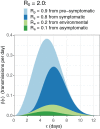Quantifying SARS-CoV-2 transmission suggests epidemic control with digital contact tracing
- PMID: 32234805
- PMCID: PMC7164555
- DOI: 10.1126/science.abb6936
Quantifying SARS-CoV-2 transmission suggests epidemic control with digital contact tracing
Abstract
The newly emergent human virus SARS-CoV-2 (severe acute respiratory syndrome-coronavirus 2) is resulting in high fatality rates and incapacitated health systems. Preventing further transmission is a priority. We analyzed key parameters of epidemic spread to estimate the contribution of different transmission routes and determine requirements for case isolation and contact tracing needed to stop the epidemic. Although SARS-CoV-2 is spreading too fast to be contained by manual contact tracing, it could be controlled if this process were faster, more efficient, and happened at scale. A contact-tracing app that builds a memory of proximity contacts and immediately notifies contacts of positive cases can achieve epidemic control if used by enough people. By targeting recommendations to only those at risk, epidemics could be contained without resorting to mass quarantines ("lockdowns") that are harmful to society. We discuss the ethical requirements for an intervention of this kind.
Copyright © 2020 The Authors, some rights reserved; exclusive licensee American Association for the Advancement of Science. No claim to original U.S. Government Works.
Figures





Comment in
-
Effectiveness of isolation measures with app support to contain COVID-19 epidemics: a parametric approach.J Math Biol. 2021 Oct 2;83(5):46. doi: 10.1007/s00285-021-01660-9. J Math Biol. 2021. PMID: 34599662 Free PMC article.
References
-
- World Health Organization, Coronavirus Disease 2019 (COVID-19): Situation Report – 36 (25 February 2020); www.who.int/docs/default-source/coronaviruse/situation-reports/20200225-....
-
- Guan W.-J., Ni Z.-Y., Hu Y., Liang W.-H., Ou C.-Q., He J.-X., Liu L., Shan H., Lei C.-L., Hui D. S. C., Du B., Li L.-J., Zeng G., Yuen K.-Y., Chen R.-C., Tang C.-L., Wang T., Chen P.-Y., Xiang J., Li S.-Y., Wang J.-L., Liang Z.-J., Peng Y.-X., Wei L., Liu Y., Hu Y.-H., Peng P., Wang J.-M., Liu J.-Y., Chen Z., Li G., Zheng Z.-J., Qiu S.-Q., Luo J., Ye C.-J., Zhu S.-Y., Zhong N.-S., China Medical Treatment Expert Group for Covid-19 , Clinical Characteristics of Coronavirus Disease 2019 in China. N. Engl. J. Med. 10.1056/NEJMoa2002032 (2020). 10.1056/NEJMoa2002032 - DOI - PMC - PubMed
-
- H. Li, S. Wang, F. Zhong, W. Bao, Y. Li, L. Liu, H. Wang, Y. He, Age-dependent risks of Incidence and Mortality of COVID-19 in Hubei Province and Other Parts of China. medRxiv 2020.02.25.20027672 [preprint]. 6 March 2020. - DOI - PMC - PubMed
-
- N. Ferguson, D. Laydon, G. Nedjati-Gilani, N. Imai, K. Ainslie, M. Baguelin, S. Bhatia, A. Boonyasiri, Z. Cucunubá, G. Cuomo-Dannenburg, A. Dighe, I. Dorigatti, H. Fu, K. Gaythorpe, W. Green, A. Hamlet, W. Hinsley, L. Okell, S. van Elsland, H. Thompson, R. Verity, E. Volz, H. Wang, Y. Wang, P. Walker, C. Walters, P. Winskill, C. Whittaker, C. Donnelly, S. Riley, A. Ghani, Impact of Non-Pharmaceutical Interventions (NPIs) to Reduce COVID-19 Mortality and Healthcare Demand (16 March 2020); www.imperial.ac.uk/media/imperial-college/medicine/sph/ide/gida-fellowsh....
Publication types
MeSH terms
Grants and funding
LinkOut - more resources
Full Text Sources
Other Literature Sources
Medical
Miscellaneous

